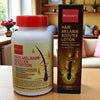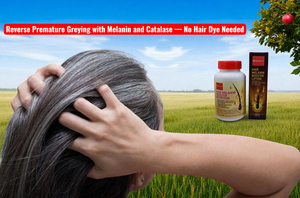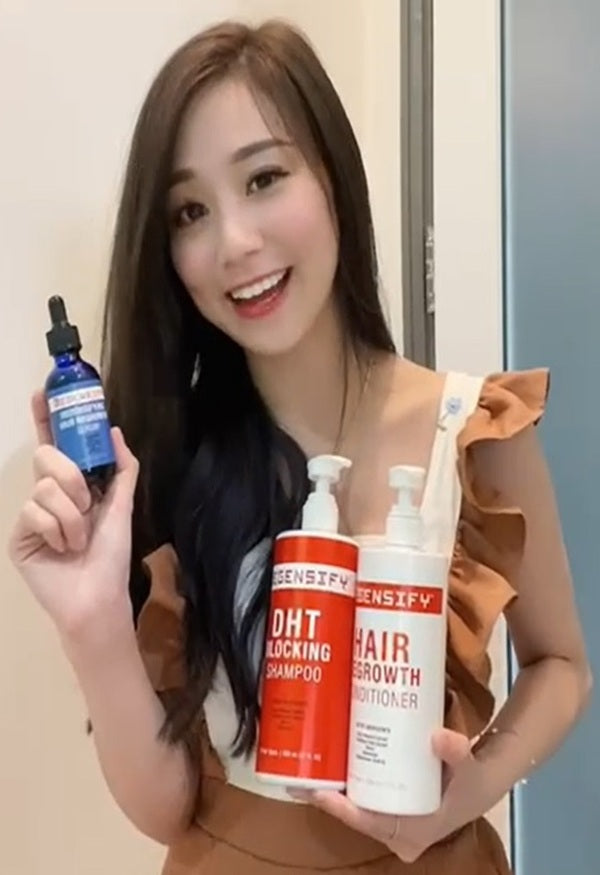WELCOME TO REGENSIFY
WELCOME TO REGENSIFY
Products
REGENSIFY Bodycare Collection

REJUVENATE YOUR BODY WITH REGENSIFY
REGENSIFY Eyecare Collection

REDENSIFY YOUR LASHES AND BROWS WITH REGENSIFY
REGENSIFY Haircare Collection

REDENSIFY YOUR HAIR WITH REGENSIFY

REVERSE GREY HAIR WITH REGENSIFY
Bundles
Reverse Premature Greying with Melanin and Catalase — No Hair Dye Needed
August 07, 2025 5 min read

Understanding Premature Greying of Hair: Causes, Myths, and Real Solutions
Grey hair has long been seen as a sign of aging. But when it starts appearing in your 20s or 30s, it’s often labeled as premature greying — a concern that affects both men and women. While many resort to hair dye or quick-fix shampoos, these may only mask the issue and could potentially make things worse. In this post, we’ll explore what causes premature greying, debunk some myths, and examine what science says about real, lasting solutions.
1. What Is Premature Greying of Hair?
Premature greying refers to the early onset of grey or white hair — typically before the age of 20 in Caucasians, 25 in Asians, and 30 in Africans. It occurs when hair follicles lose their ability to produce melanin, the pigment responsible for your natural hair color.
Several factors can contribute to this:
-
Genetics (the most common)
-
Oxidative stress
-
Vitamin deficiencies (like B12, D, folate)
-
Thyroid disorders
-
Smoking and lifestyle habits
-
Environmental toxins
Premature greying is not just a cosmetic concern — it may be a signal of underlying oxidative stress or nutrient imbalance in the body.
2. Why You Should NOT Dye Your Hair to Cover Grey
Hair dye might seem like a quick and easy fix, but it often causes more harm than good — especially over time. Here’s why:
-
Chemical overload: Most permanent dyes contain ammonia, PPD (para-phenylenediamine), and hydrogen peroxide, which can weaken the hair shaft and scalp.
-
Increased breakage and dryness: Regular use can strip natural oils and damage the hair cuticle.
-
Scalp sensitivity or allergies: Frequent dyeing increases the risk of irritation, itching, and allergic reactions.
-
Accelerates hair aging: Ironically, some of the harsh chemicals used in dyes may speed up the greying process.
If you're dealing with premature greying, treating the root cause is always better than masking the symptoms.
3. Why You Should Avoid Quick-Fix “Dye Shampoos”
You may have seen “black hair dye shampoos” that claim to reverse grey hair in just minutes. These are highly misleading — and risky.
-
Unregulated ingredients: Many contain hidden dyes and harsh chemicals that can irritate your scalp.
-
Temporary results, long-term damage: These products stain the hair temporarily but often worsen dryness and weaken follicles over time.
-
No melanin restoration: These shampoos don’t bring back your natural pigment — they just camouflage it.
- Dye shampoos are not your daily use shampoo. They can make your scalp dry and hair weak over prolonged use, leading to hair loss. Also, the dyes may also stick to your finger nails after each wash, which can be irritating.
Think of these as fast food for your hair — cheap, fast, and nutritionally void.
4. What Is Melanin?
Melanin is the natural pigment that gives your hair, skin, and eyes their color. It's produced by melanocytes, specialized cells located in the hair bulb.
There are two main types of melanin in hair:
-
Eumelanin: Responsible for black and brown tones.
-
Pheomelanin: Gives red and yellow hues.
When melanin production slows down or stops, your hair turns grey or white.
5. How Does Tyrosine Boost Melanin?
Tyrosine is a non-essential amino acid — meaning your body can produce it on its own — and it's a precursor to melanin. Here’s how it works:
-
Tyrosine is converted into L-DOPA through the action of the enzyme tyrosinase.
-
L-DOPA then helps stimulate the production of melanin in melanocytes.
-
With consistent supply and proper enzyme function, tyrosine supports healthy pigmentation in hair follicles.
Tyrosine supplementation, especially when combined with antioxidants, may help support melanin production in those experiencing oxidative stress-induced greying.
6. What Is Catalase?
Catalase is a powerful enzyme naturally produced in the body. Its main role is to break down hydrogen peroxide (H₂O₂) into water and oxygen.
Why is this important for your hair?
Because hydrogen peroxide is a by-product of cellular metabolism — and too much of it can bleach the melanin in your hair.
-
Catalase is a naturally occurring antioxidant enzyme found in nearly all living cells, including within hair follicles.
-
Its main function is to break down hydrogen peroxide (H₂O₂) — a byproduct of cellular metabolism — into water (H₂O) and oxygen (O₂).
-
As we age (or under oxidative stress), catalase levels decrease, leading to buildup of H₂O₂, which bleaches melanin and turns hair grey.
✅ In short: Catalase = your hair’s natural defense against going grey.
7. How Does Hydrogen Peroxide Destroy Melanin?
As you age — or if your body undergoes oxidative stress — hydrogen peroxide accumulates in the scalp. If not properly neutralized by catalase, this buildup can:
-
Oxidize and bleach melanin pigments, making hair appear grey or white.
-
Inhibit tyrosinase, the enzyme required to produce new melanin.
-
Damage melanocyte cells, reducing pigment production altogether.
In other words, excess hydrogen peroxide literally bleaches your hair from the inside out.
That’s why antioxidants (like catalase, CoQ10, and vitamins) and melanin precursors (like tyrosine) are gaining attention in anti-grey formulations.
8. Are There Any Approved Drugs for Anti-Grey Hair?
As of now, there are no FDA-approved drugs specifically for reversing grey hair. However, a few compounds and therapies are being researched:
-
PC-KUS (a modified pseudocatalase): Studied for conditions like vitiligo, this enzyme mimics catalase and may reduce hydrogen peroxide buildup.
-
Melanin-boosting lotions: Some topical treatments include ingredients like Geyverse, Darkenyl, MelanoGray, tyrosine, adenosine, CoQ10, and catalase to promote hair repigmentation.
-
5-ALA (5-Aminolevulinic acid): Under investigation for its role in melanin synthesis pathways.
-
Gene therapy & stem cells: Early research is exploring ways to regenerate melanocytes in the hair follicle.
Although not yet mainstream, these approaches show promise in treating the underlying causes — not just covering up the grey.
Is Greying Hair Similar to Hair Loss?
Absolutely — in fact, you can think of hydrogen peroxide (H₂O₂) as the “DHT of grey hair”.
🔹 Just like DHT shrinks your hair follicles and causes baldness, H₂O₂ builds up in your scalp and bleaches your melanin, turning hair grey.
🔹 Catalase works like a DHT blocker — it neutralizes H₂O₂ before it damages your pigment cells.
🔹 And to bring color back? Tyrosine is like your Minoxidil, Adenosine or Redensyl. It fuels melanin production the way those ingredients fuel hair regrowth.
Two problems. Different pathways. But a similar principle:
Block the root cause. Stimulate the recovery. Support the cells.
💡 Similar Analogy: Hair Greying vs. Hair Loss
| Hair Greying | Hair Loss (Androgenetic Alopecia) |
|---|---|
| Hydrogen Peroxide (H₂O₂) – The root cause that bleaches melanin and damages melanocytes | DHT (Dihydrotestosterone) – The root cause that miniaturizes hair follicles and damages dermal papilla |
| Catalase – The enzyme that neutralizes H₂O₂ to protect melanin | DHT Blockers (like finasteride or saw palmetto) – Reduce DHT levels to protect the follicle |
| Tyrosine – A melanin precursor that boosts pigment production | Hair growth stimulants like Minoxidil, Redensyl, and Adenosine – Stimulate follicle activity and stem cells |
Final Thoughts: From Quick Fix to True Hair Wellness
Grey hair is not the enemy — but premature greying can be a wake-up call about your body's internal balance. Instead of relying on chemical dyes or instant solutions that damage your hair, focus on:
-
Nourishing from within with antioxidants and melanin-supporting nutrients
-
Reducing oxidative stress from lifestyle and environmental triggers
-
Supporting your body’s natural pigment pathways with smart, safe topical formulations
Healthy hair color starts at the root — literally and figuratively.
Since there is no FDA approved drug for grey hair reversal yet, we recommend our REGENSIFY Hair Melanin Booster Lotion and REGENSIFY Hair Melanin Booster Nutrition for those who has issues with grey hair. Consider getting the bundle for extra savings. We will talk more about the REGENSIFY Hair Melanin Booster Lotion and REGENSIFY Hair Melanin Booster Nutrition in future blogs.
REVERSE GREY HAIR WITH REGENSIFY
DOWNLOAD Anti Grey Hair Product Catalog
DOWNLOAD Anti Grey Hair Clinical Study
Disclaimer: All brand names and trademarks mentioned are the property of their respective owners. This article is intended for educational and informational purposes only, based on publicly available data and clinical studies.
Leave a comment
Recent Articles
-
Dutasteride vs Finasteride vs Oral Minoxidil: Latest Insights for Male Pattern Hair Loss
October 07, 2025
-
Kordel's vs REGENSIFY vs Trichoderm: The Ultimate Melatine Supplement
September 24, 2025
-
Battle of the Anti-Grey Titans: REGENSIFY Lotion vs Trichoderm Serum
September 22, 2025
-
Melatine®: The Black Sheep Secret to Fighting Grey Hair Naturally
September 20, 2025
-
The Ultimate Anti-Grey Trio: Greyverse + Darkenyl + MelanoGray. Repair, Fuel and Protect.
September 19, 2025
-
Darkenyl + MelanoGray: Double Defense Against Grey Hairs
September 16, 2025
-
Tyrosine and Grey Hair — Oral vs Topical Solutions
September 15, 2025
-
Hair Growth vs Hair Colour: Can Minoxidil Trigger Premature Greying? A new study suggests the answer is a YES.
September 13, 2025
-
Synergy: Adenosine and Coenzyme Q10: How They Help Prevent Grey Hair
September 10, 2025
-
REGENSIFY VS VIDA GLOW - Which AnaGain™ Nu formula works best to prevent hair loss?
September 01, 2025
Latest REGENSIFY Blog Posts
Share this product

Reverse Premature Greying with Melanin & Catalase - No Hair Dye Needed
Premature greying can be a wake-up call about your body's internal balance. Get the REGENSIFY Hair Melanin Booster Lotion & Nutrition Bundle.

































